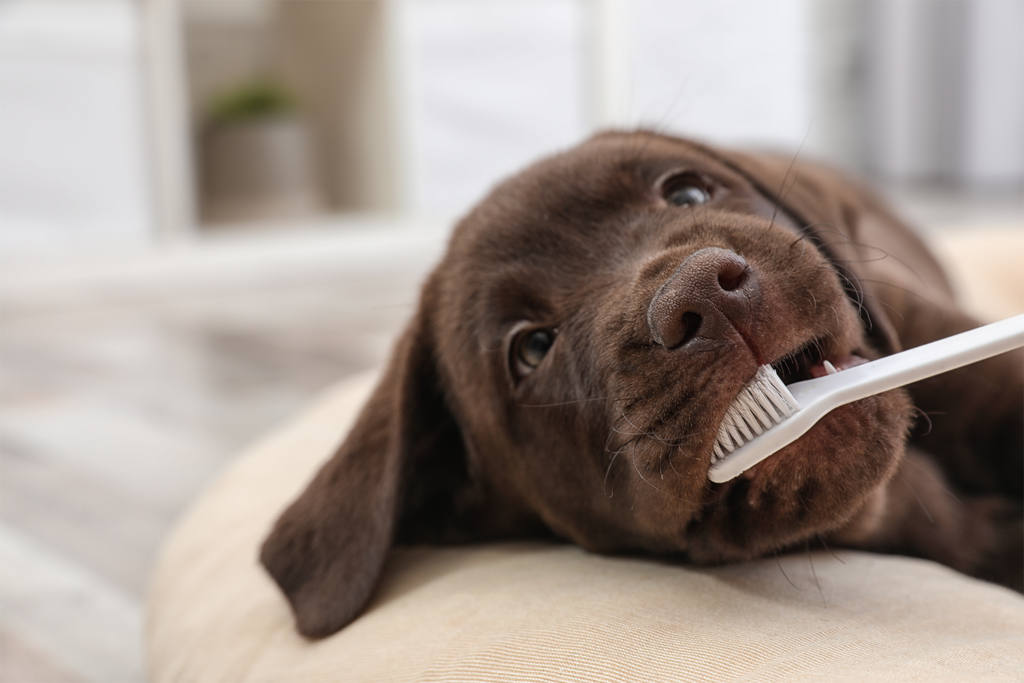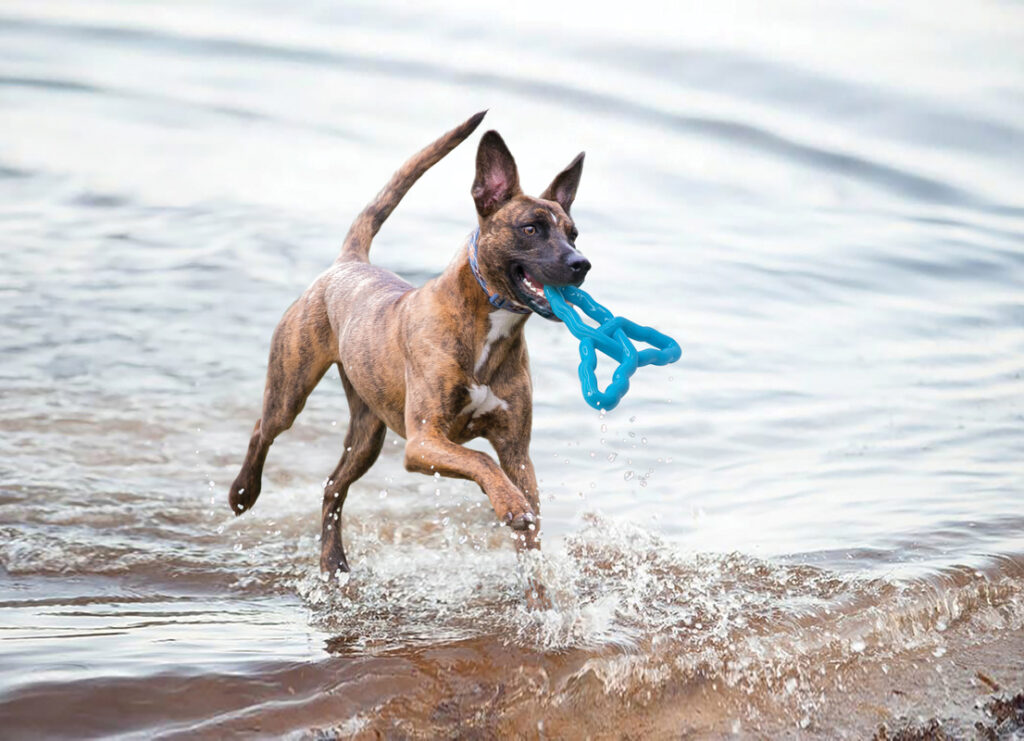Dogs can start to show symptoms of gum and dental diseases by age three, but the risk can lower with consistent tooth brushing. Recent studies have found that upwards of 86% of dogs might have periodontal disease.
What Is Periodontal Disease?
Periodontal disease is characterized as infection and inflammation of the gums due to abundant plaque bacteria. Gingivitis, a more commonly known condition, is a less severe version of periodontal disease.
The effects of poor mouth help have far-reaching implications. Bacteria from mouth infections can enter dogs’ bloodstreams, causing the bacteria to accumulate near the heart.
It’s so important to be mindful of what methods you use to clean your dog’s teeth. Do your research, and determine what types of toothpaste and dental dog toys would work best for your furbaby.
1. C.E.T. Enzymatic Dog and Cat Toothpaste
The C.E.T. Enzymatic toothpaste is a favorite among vets, pet parents, and dogs. This brand has become the #1 recommended dental product line among veterinarians, which should ease pet parents’ minds.
With C.E.T.’s dual enzyme system, this toothpaste actively fights plaque as it forms. It also lessens tartar buildup and freshens breath, two must-haves in a canine toothpaste.
This formula comes in delicious flavors that any pet will love, turning brushing time into fun time. Cleanse your pet’s palette with flavors like seafood, beef, poultry, and vanilla-mint.
The formula works for both dogs and cats, so multi-pet households will not have to look any further.
2. Toys That Clean Your Dog’s Teeth
A traditional toothbrush and toothpaste are far from the only ways to ensure a healthy mouth for your pet. Whether your dog does not tolerate brushing or if you want another method to help, dental toys are a wonderful option.
In order to make your dog’s teeth cleaning routine fun, look into toys such as the KONG Dental Stick™.
Your dog loves this toy because it satisfies their natural instincts to chew and chase. Meanwhile, you love this toy because the unique rubber grooves clean your pet’s teeth as they play. That’s equal parts mental enrichment and dental health help. Plus, with three sizes, every dog member of your household can get in on the fun.
Looking for a little more guidance? KONG has just the thing to help your fluffy friend thrive:
3. Try Dental Treats
Making the teeth cleaning process a pleasant one can seem challenging, but dental treats make it easy!
KONG’s Ziggies Dental Treats put the “fun” in function. They’re chicken flavored, so dogs can’t get enough. Meanwhile, pet parents can’t get enough of how fresh their dog’s breath is.
4. Pick a Toothpaste With a Flavor Everyone Can Agree On
Dog toothpaste doesn’t come in flavors like bubblegum or cinnamon. Our dogs are much more excited about bacon and other meat-inspired recipes.
However, pet parents will still have to smell their dog’s breath afterward.
Some pet parents prefer to use unflavored toothpaste that leaves no smell behind. Your dog might not be as excited about the taste, but that is okay if they don’t mind brushing. A more pungent flavor might be best for dogs who are less than happy about getting their teeth brushed.
5. Formulas With All-Natural Ingredients
For dogs with more sensitive stomachs or pet parents who prefer more organic products, there are formulas for you:
Some dog toothpastes utilize ingredients such as aloe vera. Not only will aloe vera freshen your dog’s breath, but it will also soothe unpleasant symptoms that arise due to gum disease. Other all-natural toothpaste ingredients might include coconut oil, sweet potato, and olive leaf extract.
6. Fluoride-Free Toothpaste
Unlike humans, dogs are going to swallow almost all of their toothpaste. This means that their formulas cannot include potentially harmful ingredients.
Both humans and dogs are better off avoiding parabens and sulfates. However, human dentists recommend fluoride for people’s toothpaste. This is where our similarities end.
Fluoride is dangerous to dogs which is why pet parents and pets should never share a tube of toothpaste.
7. Formulas Without Artificial Sweeteners Like Xylitol
Artificial sweeteners are not ideal for anyone, but common ingredients like xylitol pose a real threat to dogs. This artificial sweetener can cause hypoglycemia in dogs. Hypoglycemia is a serious drop in blood sugar that can lead to coma or even death.
How Often Should You Brush Your Dog’s Teeth?
Dogs should have their teeth brushed roughly as often as humans.
If you are not yet ready to commit to brushing your dog’s teeth on the same schedule as yours, you have options. A dog’s teeth must be brushed at least three times per week to effectively remove plaque, bacteria, and other buildup. Many pet parents will land somewhere between these two frequencies. Our friends at PetKeen have created a visual guide to help you learn the best way to brush your pups teeth.
Signs That Your Dog’s Teeth Need More Brushing
It is often difficult for pet parents to recognize when their dog is experiencing oral pain. Dogs can be quite adept at hiding these issues, so we have to be on alert to see warning signs as they come up. By the time they are eating less due to pain, the issue is already quite severe.
Some symptoms of gum disease in dogs include:
- Red or inflamed gums
- Eating less or reduced appetite
- Unpleasant odor around the mouth
- Discolored teeth
- Drooling
- Missing teeth
Should You Start Brushing Your Dog’s Teeth as a Puppy?
The earlier you start brushing your dog’s teeth, the better.
First, cleaning your dog’s teeth from an early age means that plaque and bacteria will not have the chance to build up, helping your dog’s teeth in the long run.
By starting your dog on a brushing routine when they are young, you are also getting them used to having their teeth brushed. Handling dogs all over their bodies is a necessary part of the socialization process. When this is done early, dogs are better adjusted and more comfortable as adults.
If an adult dog has never had their teeth brushed as a puppy, they might not tolerate it well. However, if they understand that there is no threat to their teeth being brushed, they will learn to tolerate it. As time goes on, they could even learn to enjoy the process.
How Do You Brush a Dog’s Teeth?
Once pet parents understand the importance of brushing their dogs’ teeth, their next question is inevitable: How do you do it? Though the prospect might seem intimidating at first, it does not have to be.
When brushing your dog’s teeth, focus more on lifting their lip rather than forcibly opening their mouth. Use small circular motions to thoroughly clean their teeth. If your dog can only tolerate so much handling, spend most of your time on the back teeth. The top back teeth are especially likely to suffer from gum disorders.
If you find it difficult to keep your dog still while brushing their teeth, it might be a matter of position. Next time, try to get either behind or beside your dog, depending on their size.
Use your arm to steady their head, but not to force it in any one position. If your dog views getting their teeth brushed as a very negative experience, it will be even more difficult in the future.
It’s best to start with shorter brushing sessions and gradually increase the time. For dogs just getting started, try introducing them to the brush with the (yummy) toothpaste, letting them taste it.
Additionally, you want to make the whole process as positive as possible. Try feeding your dog shortly after, praising, playing, or petting them. You know your dog best, so opt for what incentivizes them the most.
How Else Can We Help Our Dogs’ Teeth?
In addition to regularly brushing your dog’s teeth, you should also take your dog to the vet for special dental visits. Most veterinary professionals recommend that dogs get their teeth professionally looked at once per year, starting as puppies.
This visit can involve a teeth cleaning or potential X-Rays. Your vet will also visually inspect your dog’s mouth.
The best way to ensure your dog’s smile remains healthy for years to come is by combining an at-home dental routine with regular dental visits. We indeed know our pets best, but vets are specifically trained to see abnormalities that we might not know about.
Brushing Up
Over time, dental issues that seem insignificant can become serious problems. If left unattended, dental disease can lead to issues in your dog’s heart, liver, and kidneys. These issues can be lessened or thwarted entirely if a dental routine is established and closely followed.
If you have more questions about your canine’s canines, you can reach out to the vets and pet experts in the KONG Club App for personalized care tips and tricks.
Sources:
Periodontal Disease in Small Animals | Merck Vet Manual
Hypoglycemia in Dogs: Causes, Management, and Diagnosis | PMC
Periodontal Disease in Dogs: Symptoms, Causes & Treatment | Greensboro Vet
Fluoride Poisoning – Special Pet Topics | Merck Veterinary Manual



